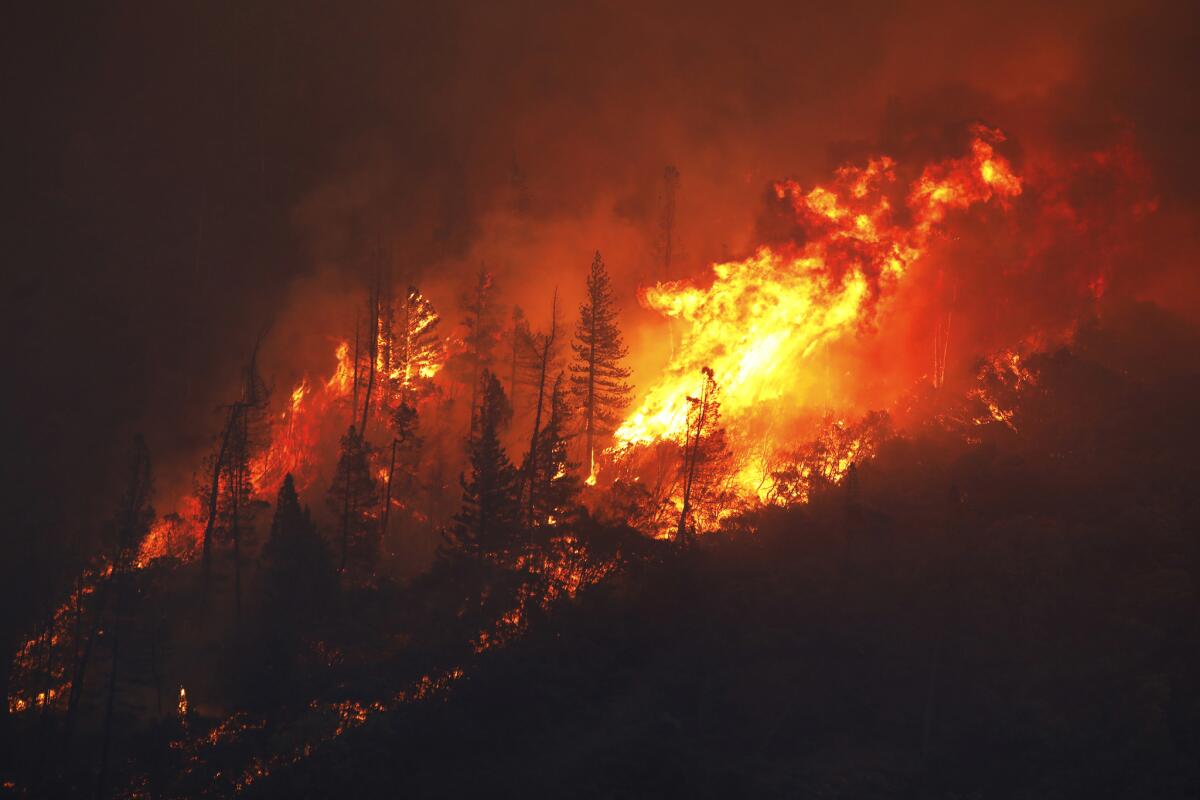PG&E reaches $13.5-billion settlement with victims of devastating California wildfires

- Share via
Pacific Gas & Electric on Friday announced a $13.5-billion settlement for several Northern California wildfires that killed dozens of people and destroyed thousands of homes and businesses.
The settlement with victims covers some of the worst fires in the state’s modern history, including the wine country blazes in 2017 and the fire that nearly destroyed the town of Paradise in 2018.
“We want to help our customers, our neighbors and our friends in those impacted areas recover and rebuild after these tragic wildfires,” Chief Executive Bill Johnson said in a statement.
The announcement also comes as the utility faces an uncertain future. PG&E’s transmission equipment has been widely blamed for repeatedly sparking wildfires, and the utility has not contested damning findings of recent investigations.
The utility has filed for Chapter 11 bankruptcy protection, but is trying to remain financially viable. The utility says the settlement is a step in that direction.
“With this important milestone now accomplished, we are focused on emerging from Chapter 11 as the utility of the future that our customers and communities expect and deserve,” Johnson said.
Richard Bridgford, an attorney who is part of the team representing the victims, called the settlement a “delicate balance” that has three goals: compensating victims as much as possible, deterring future “bad behavior” by the utility and allowing the utility to remain financially viable — in large measure so that it can upgrade safety measures while continuing to provide power to its customers.
“We have changed the corporate calculus for PG&E,” Bridgford said. “It will not be business as usual because they cannot afford this corporate liability.”
PG&E is an investor-owned utility that, critics say, too often puts short-term profits before necessary safety measures.
The Camp fire, which raced through Paradise in 2018, killed 86 people and destroyed more than 13,900 homes. Both the California Public Utilities Commission and the state Department of Forestry and Fire Protection concluded that poorly maintained PG&E equipment sparked that blaze.
The commission also noted that for years, PG&E failed to do climbing inspections of a century-old tower that malfunctioned, causing sparks where the fire originated. Investigators said there was “visible wear” on the arms of a tower linked to the blaze, but that PG&E crews had not climbed the tower since at least 2001.
Such an inspection could have identified problems with a small metal hook that was supposed to hold up a transmission line and insulator on the tower, and “its timely replacement could have prevented the ignition of the Camp fire,” investigators said.
The omission of climbing inspections on the failed tower “is a violation of PG&E’s own policy requiring climbing inspections on towers where recurring problems exist,” investigators wrote.
Other fires covered in the settlement include the Tubbs fire in 2017, the Ghost Ship fire in an Oakland warehouse in 2016 and the Butte fire in 2015.
The wine country fires in 2017 scorched more than 200,000 acres mostly in Napa County, destroyed or damaged more than 5,500 homes, displaced 100,000 people and killed at least 41.
Misconduct by PG&E is not the only factor contributing to the intensity and expanse of the blazes, though. In the last 20 years, more acres have burned in the wine country region than in the entire previous half-century, fueled by rising temperatures and the effects of Diablo winds on increasingly dry terrain.
The increasingly dangerous natural conditions tied to climate change have raised the stakes for what can happen when human error or corporate misdirection is added to the equation. PG&E’s aging infrastructure, in some cases, has then provided the literal spark.
The Ghost Ship fire was different. It erupted in a Bay Area warehouse where people were living in hazardous conditions. Thirty-six people died. Some victims blame PG&E equipment, although the cause of that fire has been disputed.
This new agreement is the utility’s third major recent settlement. PG&E already had agreed to pay $1 billion to cities, counties and other public entities, and $11 billion to insurance companies and other entities that have already paid claims relating to the 2017 and 2018 wildfires.
This settlement is intended to help victims with no insurance and victims whose insurance was not enough to cover their losses. People have until Dec. 31 to file initial claims for a share from the trust fund that the settlement will create.
The settlement does not cover PG&E’s potential liability for more recent fires, including this year’s Kincade fire, which also tore through parts of wine country.
More to Read
Sign up for Essential California
The most important California stories and recommendations in your inbox every morning.
You may occasionally receive promotional content from the Los Angeles Times.














